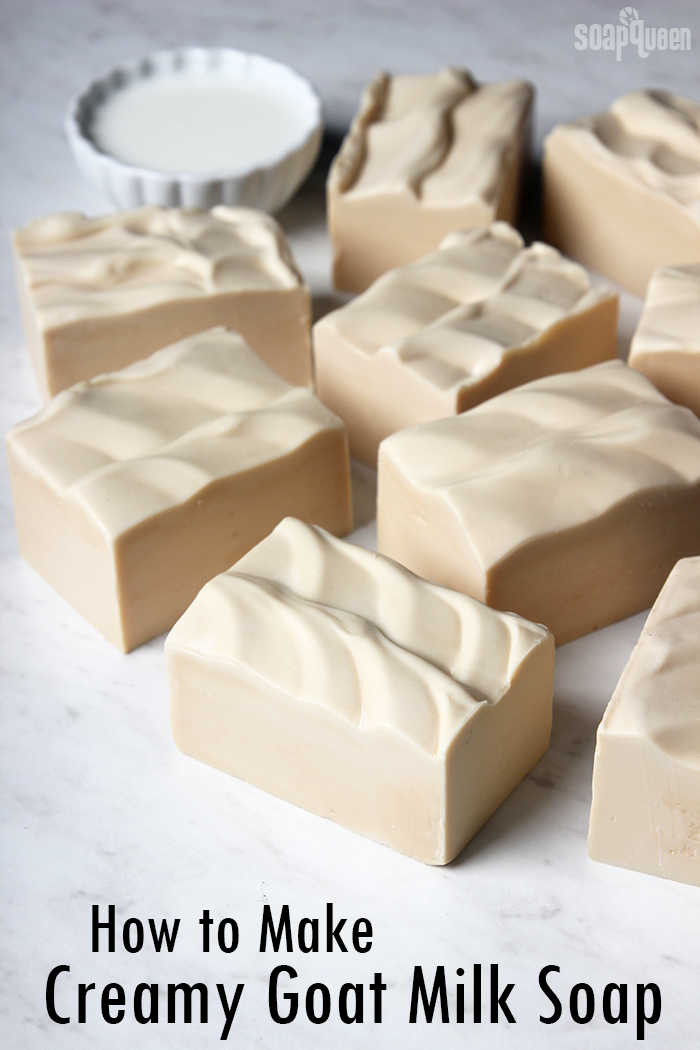
Goat milk soap is well known for its creamy lather and skin-loving properties. Goat milk is particularly nourishing because of capric-caprylic triglyceride, which helps form a barrier on the skin to help inhibit the loss of moisture. Goat milk also contains vitamins A, D and B6, as well lactic acid which is thought to contribute to skin smoothness. It’s no wonder why goat milk soap is loved by so many!
This goat milk soap recipe contains goat milk from a local farm. Using fresh goat milk is a fantastic way to highlight local products and the unique, handmade properties of your goat milk soap. If you can’t get your hands on fresh goat milk in your area, powdered goat milk is a great alternative. You may also find goat milk at your local grocery store, co-op or farmer’s market.
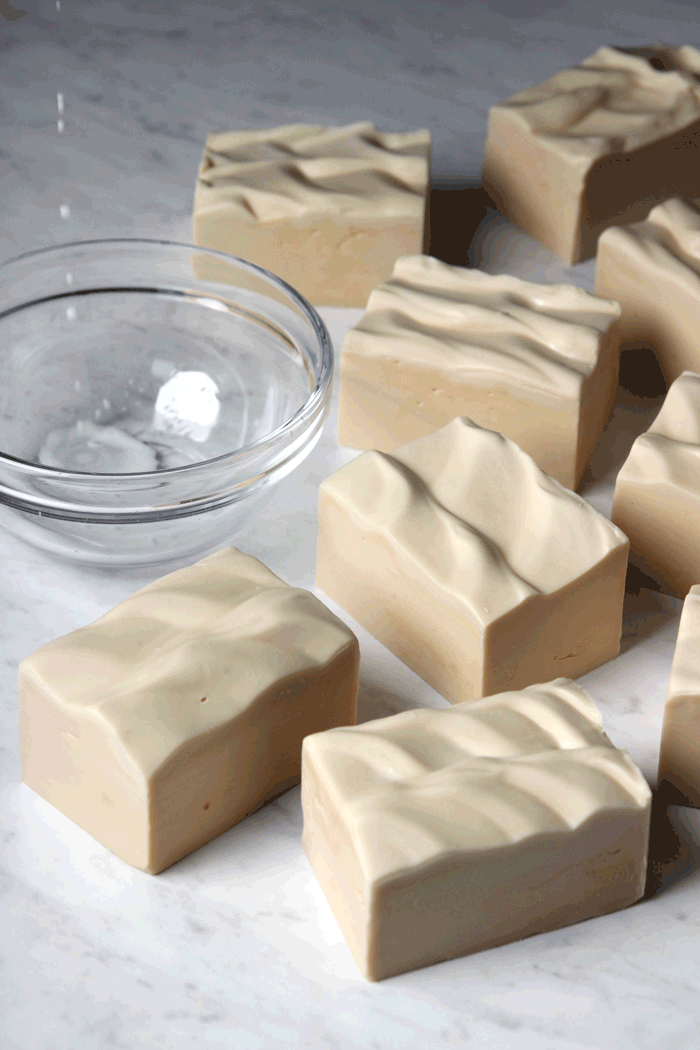
Creating goat milk soap does take some extra prep work. If you’ve never tried making milk soap before, you may want to get a simpler cold process soap recipe under your belt first (this one is great!). Adding lye to milk can scorch the milk without proper preparation. Freezing the milk first keeps temperatures cool and prevents scorching. Learn how to prep milk for milk soap, and watch this Goat Milk Soap video to see the process in action.
If you’re ready to dive into goat milk soap for the first time, this recipe is perfect. It’s simple with one color and a thick texture, so no need to worry stick blending too much. It’s scented with Oatmeal Milk and Honey, one of our all-time most popular fragrance oils. It does discolor in cold process soap, so titanium dioxide is added to keep the bars light and creamy looking. There is something so appealing about a simple bar of creamy milk soap!
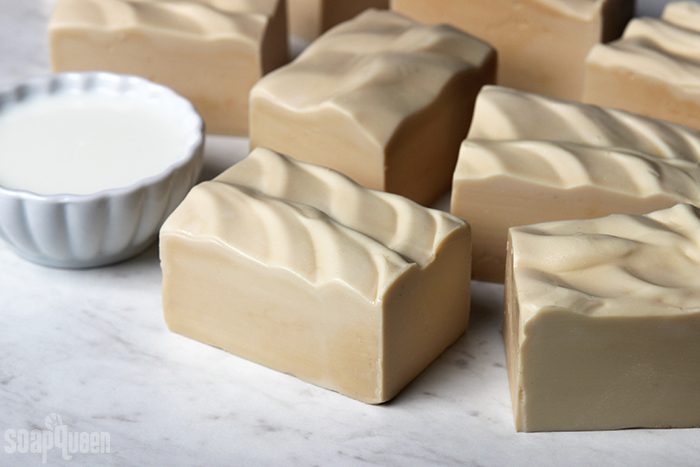
What You’ll Need:
9 Bar Birchwood Mold
Silicone Liner for 9 Bar Mold
5.3 Apricot Kernel Oil (15%)
8.8 oz. Coconut Oil (25%)
11.5 oz. Olive Oil Pomace (33%)
2.5 oz. Cocoa Butter Cubes (7%)
7 oz. Palm Oil (20%)
4.9 oz. Sodium Hydroxide Lye
11.6 oz. Goat Milk
2 oz. Oatmeal Milk and Honey Fragrance Oil
Titanium Dioxide

Click here to add everything you need for this project to your Bramble Berry shopping cart!
MILK PREP: When lye is added to milk, it causes the milk to reach temperatures up to 200 ° F. This scorches the milk, causing it to smell bad and develop a dark yellow color. A technique to prevent the milk from scorching is to keep temperatures as cool as possible. Our preferred technique is to freeze the goat milk, and add the sodium hydroxide lye flakes directly to the frozen milk. To keep the milk extra, extra cold, you can place the container of frozen milk into a larger container with ice. In this project we skipped this step, but it’s a personal preference.
First, measure out 11.6 ounces of goat milk. Then, pour the milk into ice cube trays (in this case we used Medium 9 Ball Silicone Molds). Allow the milk to fully freeze. Once frozen, empty the milk ice cubes into a container appropriate for mixing lye. When adding the milk ice cubes to the container, place the container on a scale to make sure you have the correct amount of milk. Although it was measured previously, some milk might be lost in the freezing/transferring process. If you’re missing some milk, pour cold goat milk into the container to supplement what you have. Adding distilled water to supplement would also be okay.
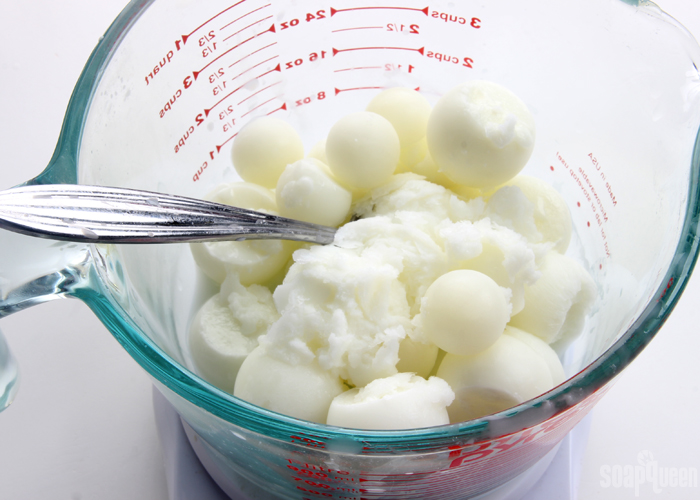 SAFETY FIRST: Suit up for safe handling practices! That means goggles, gloves and long sleeves. Make sure kids, pets, and other distractions and tripping hazards are out of the house or don’t have access to your soaping space. Always soap in a well-ventilated area.
SAFETY FIRST: Suit up for safe handling practices! That means goggles, gloves and long sleeves. Make sure kids, pets, and other distractions and tripping hazards are out of the house or don’t have access to your soaping space. Always soap in a well-ventilated area.
LYE PREP: With safety gear on, slowly add about 1/4 of the lye flakes directly to the frozen goat milk. Use a non-reactive spoon to stir the lye flakes and goat milk together. Slowly, the flakes will begin to melt the goat milk cubes. After a few minutes of stirring, add another 1/4 of the flakes and continue stirring for several minutes.
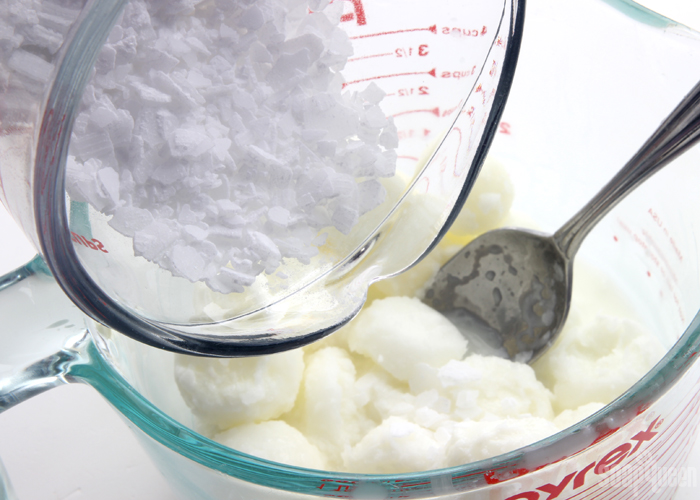
Continue this process until all the lye flakes have been added to the goat milk. Continue stirring and stirring…and stirring! The goat milk will continue to melt as more lye is added and stirred. Once the milk has fully melted, continue to stir to make sure all the lye flakes have completely dissolved. Because the temperatures are low, the lye flakes do not dissolve as quickly. Listen and look for lye flakes on the bottom of your container; lye flakes can take a lot longer to dissolve in cooler temperature liquids. Patience is key! Any undissolved lye in your soap could cause skin irritation, or even lye burns, so take extra time to make sure all the lye is dissolved.
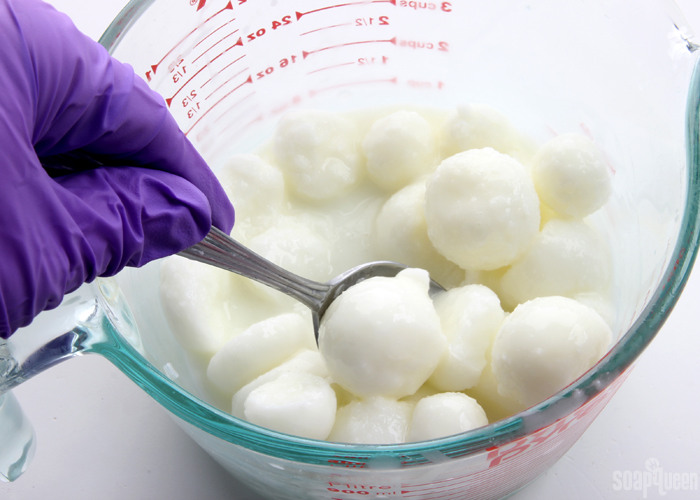
Once all the lye has been added, the milk may become yellow. Below, our milk reached about 90 ° F and developed a very slight yellow color. This color of milk is suitable for this recipe. But, if you’d like to make sure your soap batter is as light as possible for your color palette, placing the container of frozen milk into an ice bath container helps keep temperatures cooler, as shown in this post. If you’d like a harder bar of soap that releases faster from the mold, you can add sodium lactate to the milk solution. Use 1 teaspoon of sodium lactate per pound of oils in the recipe. For this recipe, you’d add 2 teaspoons sodium lactate.
Now that the lye and milk solution is prepped, it’s time to prep the other ingredients.
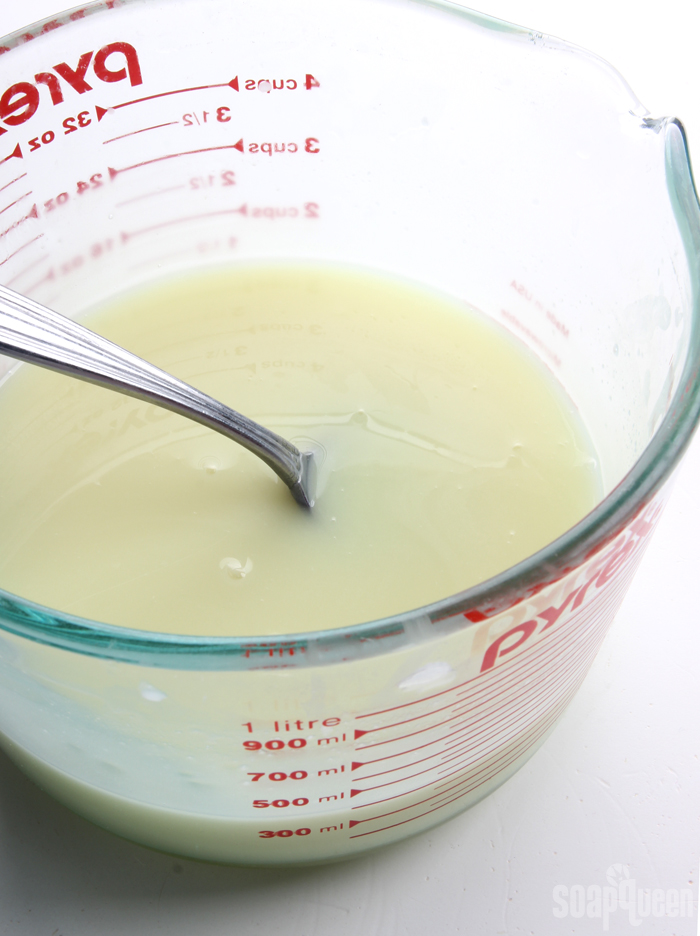 COLOR PREP: To ensure that the titanium dioxide blends smoothly into the soap batter, we recommend micronizing it before dispersing it in oil. Please note this is an optional tip but it does help with the titanium dioxide clumping in the soap. =) To micronize colorant, simply use a coffee grinder to blend the colorant to break up any clumps of color and prevent streaks of white from showing in the final soap. We like to use a coffee grinder that has a removable, stainless steel mixing area for easy cleaning. Disperse 3 teaspoons of titanium dioxide into 2 tablespoons of lightweight liquid oil, like sweet almond oil or sunflower oil. In this recipe, we used a slightly more concentrated colorant-oil ratio to avoid adding too much extra oil.
COLOR PREP: To ensure that the titanium dioxide blends smoothly into the soap batter, we recommend micronizing it before dispersing it in oil. Please note this is an optional tip but it does help with the titanium dioxide clumping in the soap. =) To micronize colorant, simply use a coffee grinder to blend the colorant to break up any clumps of color and prevent streaks of white from showing in the final soap. We like to use a coffee grinder that has a removable, stainless steel mixing area for easy cleaning. Disperse 3 teaspoons of titanium dioxide into 2 tablespoons of lightweight liquid oil, like sweet almond oil or sunflower oil. In this recipe, we used a slightly more concentrated colorant-oil ratio to avoid adding too much extra oil.
FRAGRANCE PREP: Measure 2 ounces of Oatmeal Milk and Honey Fragrance Oil into a glass, fragrance oil safe container. Set aside.
ONE: Fully melt and combine the coconut oil, palm oil, olive oil pomace, cocoa butter, apricot kernel oil (remember to fully melt then mix your entire container of palm oil before portioning). Once the oils have cooled to 130 degrees or below (the milk lye solution will be on the cooler side, that’s okay), add the Oatmeal Milk and Honey Fragrance Oil directly to the oils. Usually fragrance oils are added at trace, but because we know this fragrance behaves so well and thin trace is not a concern, it can be added first.
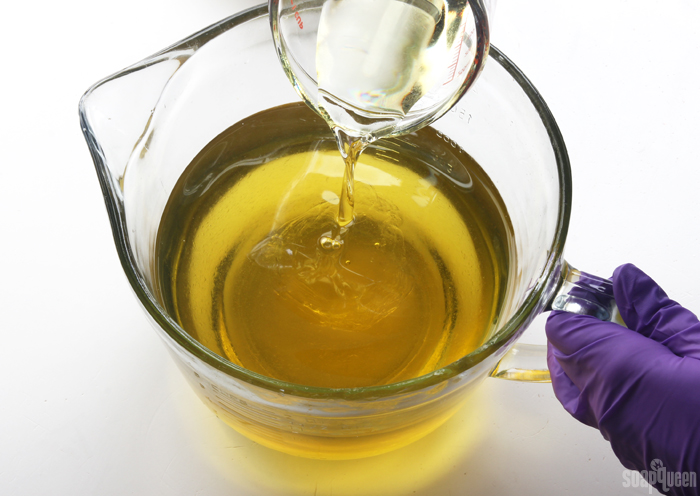 TWO: Add the milk and lye solution slowly to the oils. As you add the milk, begin pulsing your stick blender. Because the milk and lye solution is on the cooler side and the recipe contains hard oils that solidify at cooler temperature, adding the lye and milk solution gradually can help prevent false trace.
TWO: Add the milk and lye solution slowly to the oils. As you add the milk, begin pulsing your stick blender. Because the milk and lye solution is on the cooler side and the recipe contains hard oils that solidify at cooler temperature, adding the lye and milk solution gradually can help prevent false trace.
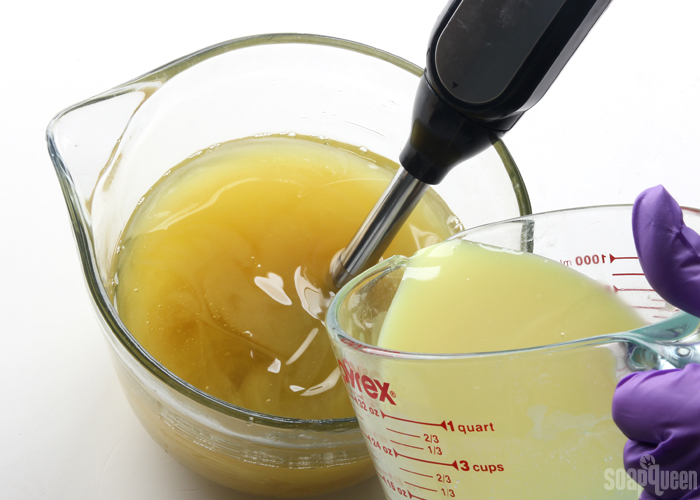 THREE: Once all the lye solution has been added, continue to blend until thin to medium trace.
THREE: Once all the lye solution has been added, continue to blend until thin to medium trace.
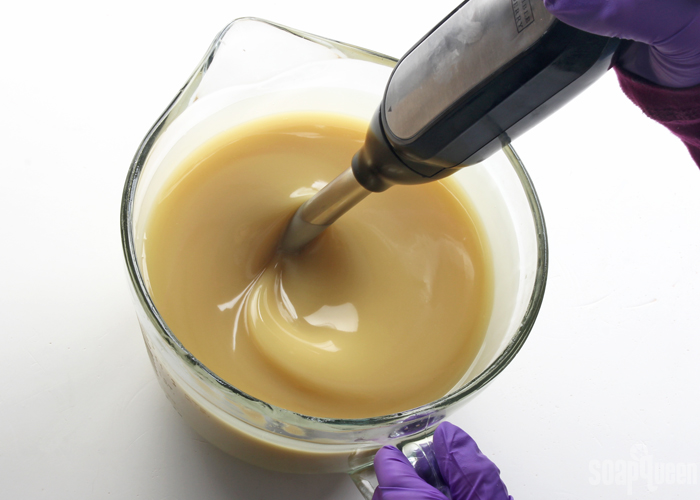
FOUR: Add all the dispersed titanium dioxide, and use the stick blender to stir and blend the colorant into the batter using short bursts.
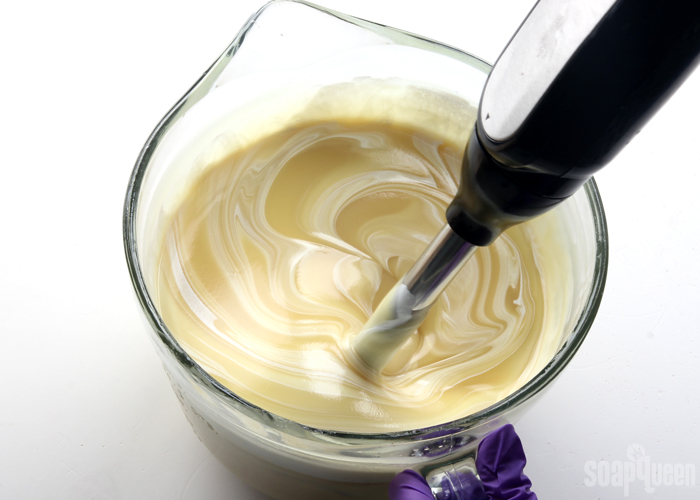
FIVE: Once the colorant is completely incorporated, pour the soap into the mold. Tap it firmly on the counter to eliminate air bubbles, and use a spoon or spatula to spread the soap evenly into the mold.
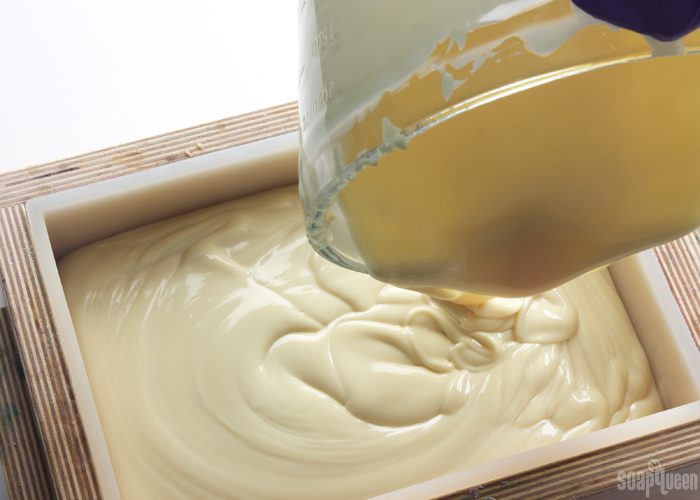 SIX: Using a small stainless steel spoon, create texture on the top of the soap. There is no right or wrong way to do this, so have fun with it!
SIX: Using a small stainless steel spoon, create texture on the top of the soap. There is no right or wrong way to do this, so have fun with it!
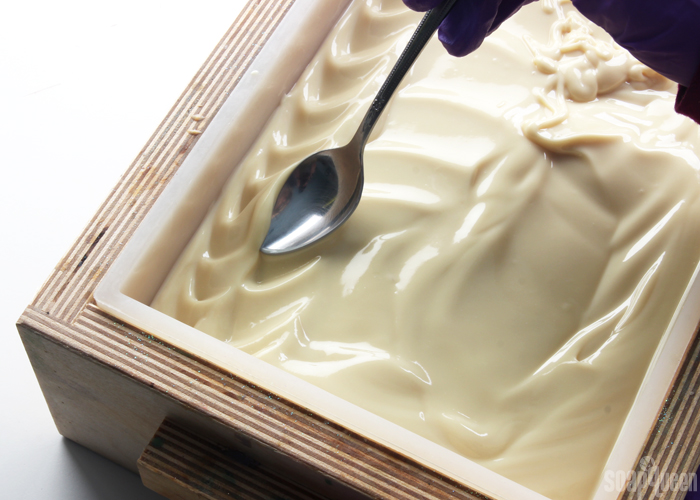 SEVEN: Once you’re happy with the top, insert the dividers into the mold. Push the dividers all the way to the bottom of the mold. Spray the top of the soap with 99% isopropyl alcohol to help avoid soda ash. Milk soap has a tendency to heat up due to the sugar in the milk. To keep it cool, place the soap in the fridge or freezer for at least 3 hours, up to overnight. Then, allow it to sit in the mold for about 3-4 days. Soap that is placed in the fridge or freezer for the first few hours of saponification can take a little longer to unmold. If you find the silicone liner is not pulling away from the sides of the mold easily, give it another day to unmold. Remove the soap from the dividers (see the unmolding process in this video here) and allow the bars to cure for 4-6 weeks. Enjoy your goat milk soap!
SEVEN: Once you’re happy with the top, insert the dividers into the mold. Push the dividers all the way to the bottom of the mold. Spray the top of the soap with 99% isopropyl alcohol to help avoid soda ash. Milk soap has a tendency to heat up due to the sugar in the milk. To keep it cool, place the soap in the fridge or freezer for at least 3 hours, up to overnight. Then, allow it to sit in the mold for about 3-4 days. Soap that is placed in the fridge or freezer for the first few hours of saponification can take a little longer to unmold. If you find the silicone liner is not pulling away from the sides of the mold easily, give it another day to unmold. Remove the soap from the dividers (see the unmolding process in this video here) and allow the bars to cure for 4-6 weeks. Enjoy your goat milk soap!
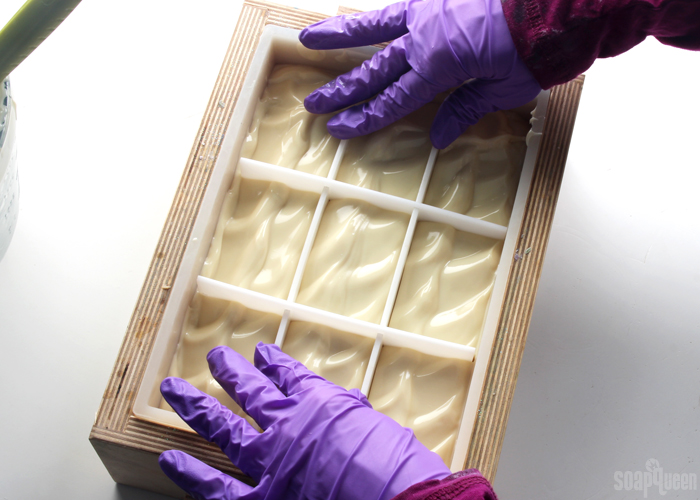
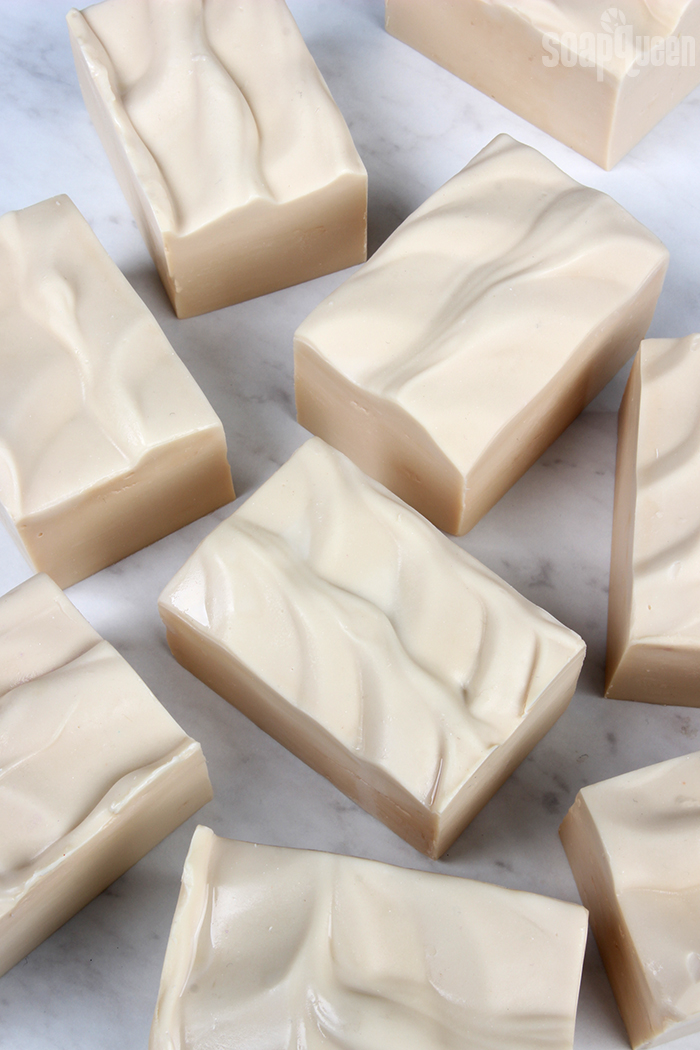
- 9 Bar Birchwood Mold
- Silicone Liner for 9 Bar Mold
- 5.3 Apricot Kernel Oil (15%)
- 8.8 oz. Coconut Oil (25%)
- 11.5 oz. Olive Oil Pomace (33%)
- 2.5 oz. Cocoa Butter Cubes (7%)
- 7 oz Palm Oil (20%)
- 4.9 oz. Sodium Hydroxide Lye
- 11.6 oz. Goat Milk
- 2 oz. Oatmeal Milk and Honey Fragrance Oil
- Titanium Dioxide
- Fully melt and combine the coconut oil, olive oil pomace, cocoa butter, apricot kernel oil, and palm oil (remember to fully melt then mix your entire container of palm oil before portioning). Once the oils have cooled to 130 degrees or below (the milk lye solution will be on the cooler side, that's okay), add the Oatmeal Milk and Honey Fragrance Oil directly to the oils. Usually fragrance oils are added at trace, we know this fragrance behaves so well and thin trace is not a concern, it can be added first.
- Add the milk and lye solution slowly to the oils. As you add the milk, begin pulsing your stick blender. Because the milk and lye solution is on the cooler side and the recipe contains hard oils that solidify at cooler temperatures, adding the lye and milk solution gradually can help prevent false trace.
- Once all the lye solution has been added, continue to stick blend until you reach thin to medium trace.
- Add all the dispersed titanium dioxide, and use the stick blender to stir and blend the colorant into the batter using short bursts.
- Once the colorant is completely incorporated, pour the soap into the mold. Tap it firmly on the counter to eliminate air bubbles, and use a spoon or spatula to spread the soap evenly into the mold.
- Using a small stainless steel spoon, create texture on the top of the soap. There is no right or wrong way to do this, so have fun with it!
- Once you’re happy with the top, insert the dividers into the mold. Push the dividers all the way to the bottom of the mold. Spray the top of the soap with 99% isopropyl alcohol to help avoid soda ash. Milk soap has a tendency to heat up due to the sugar in the milk. To keep it cool, place the soap in the fridge or freezer for at least 3 hours, up to overnight. Then, allow it to sit in the mold for about 3-4 days. Soap that is placed in the fridge or freezer for the first few hours of saponification can take a little longer to unmold. If you find the silicone liner is not pulling away from the sides of the mold easily, give it another day to unmold. Remove the soap from the dividers (see the unmolding process in this video here) and allow the bars to cure for 4-6 weeks. Enjoy!
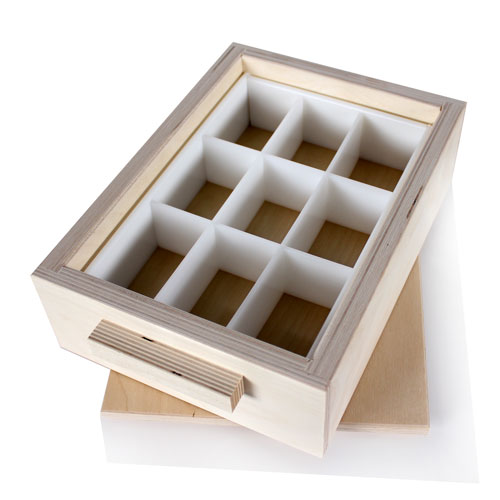
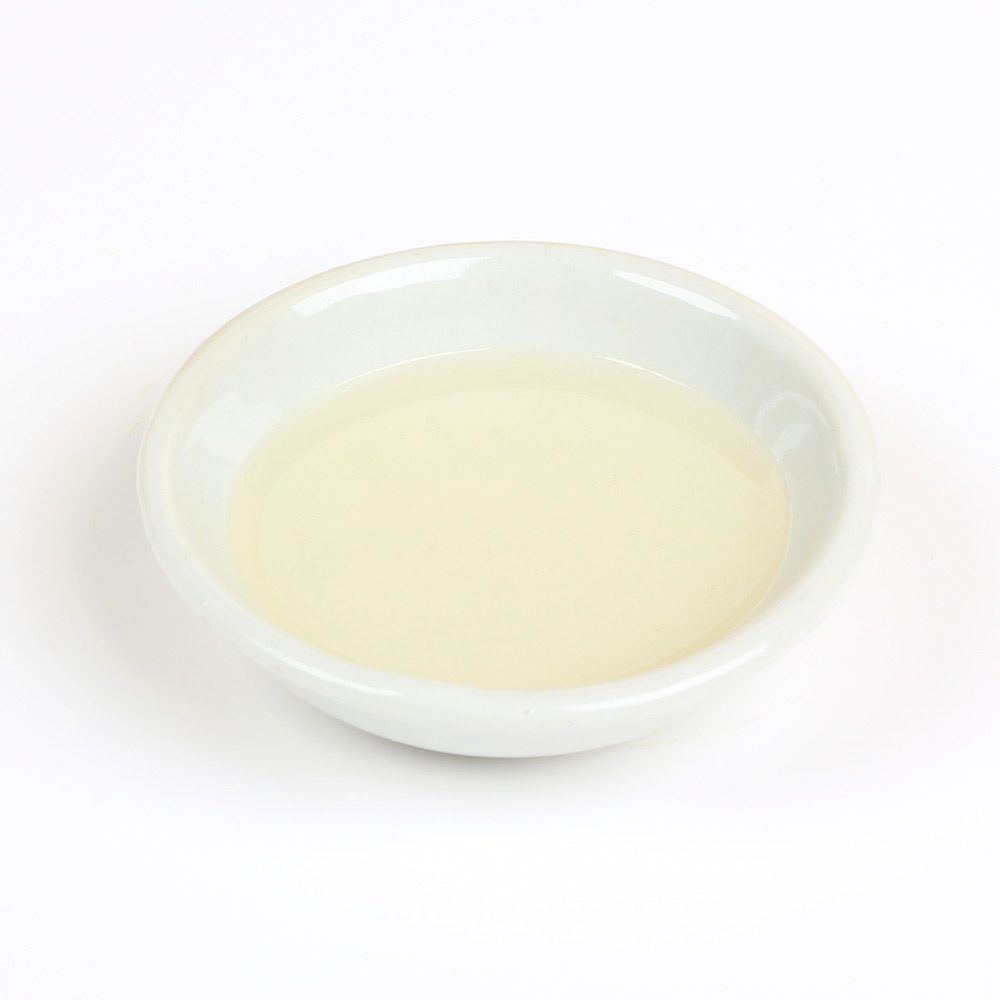
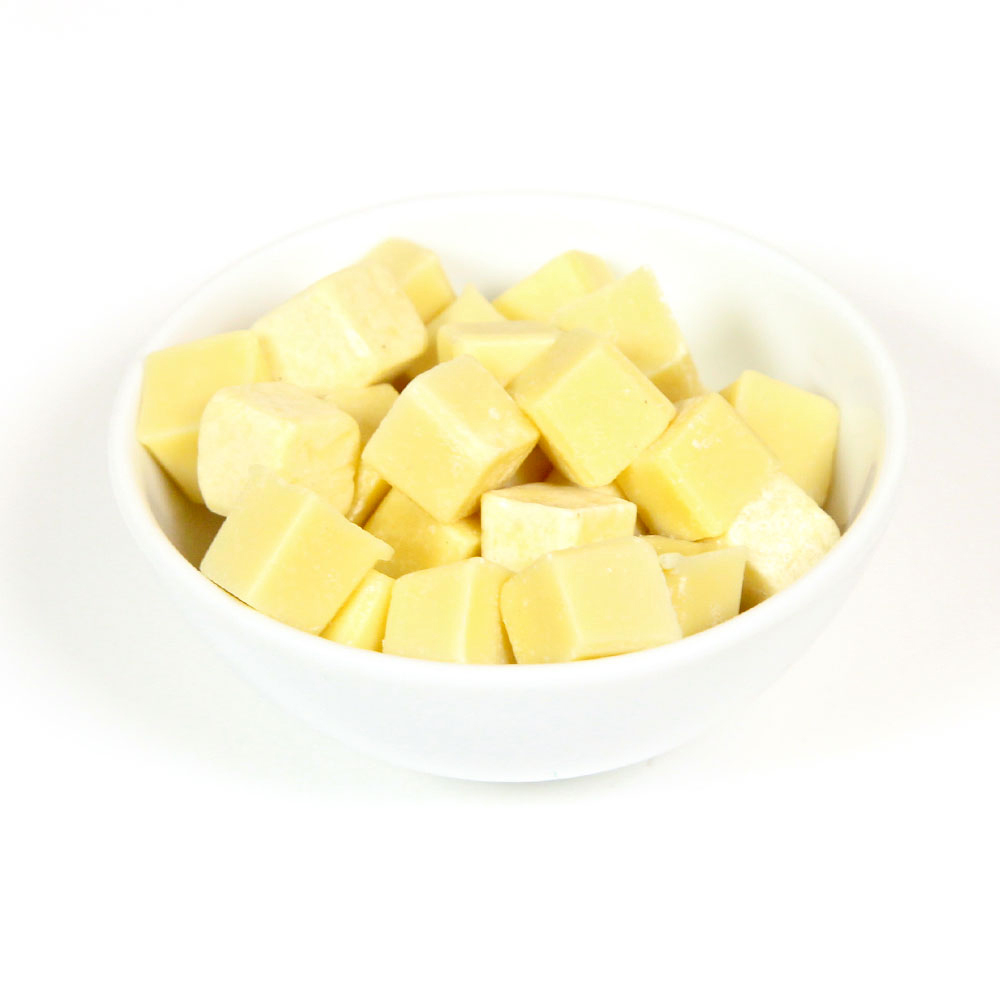
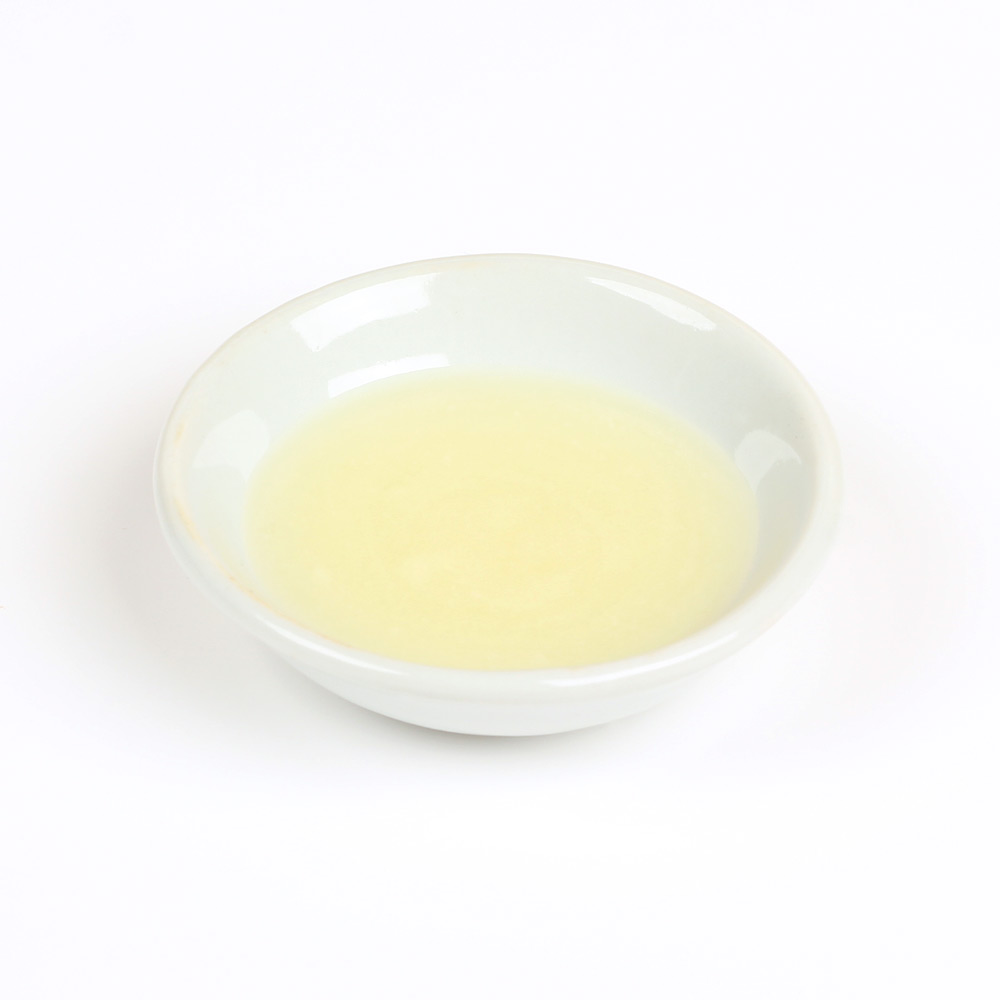
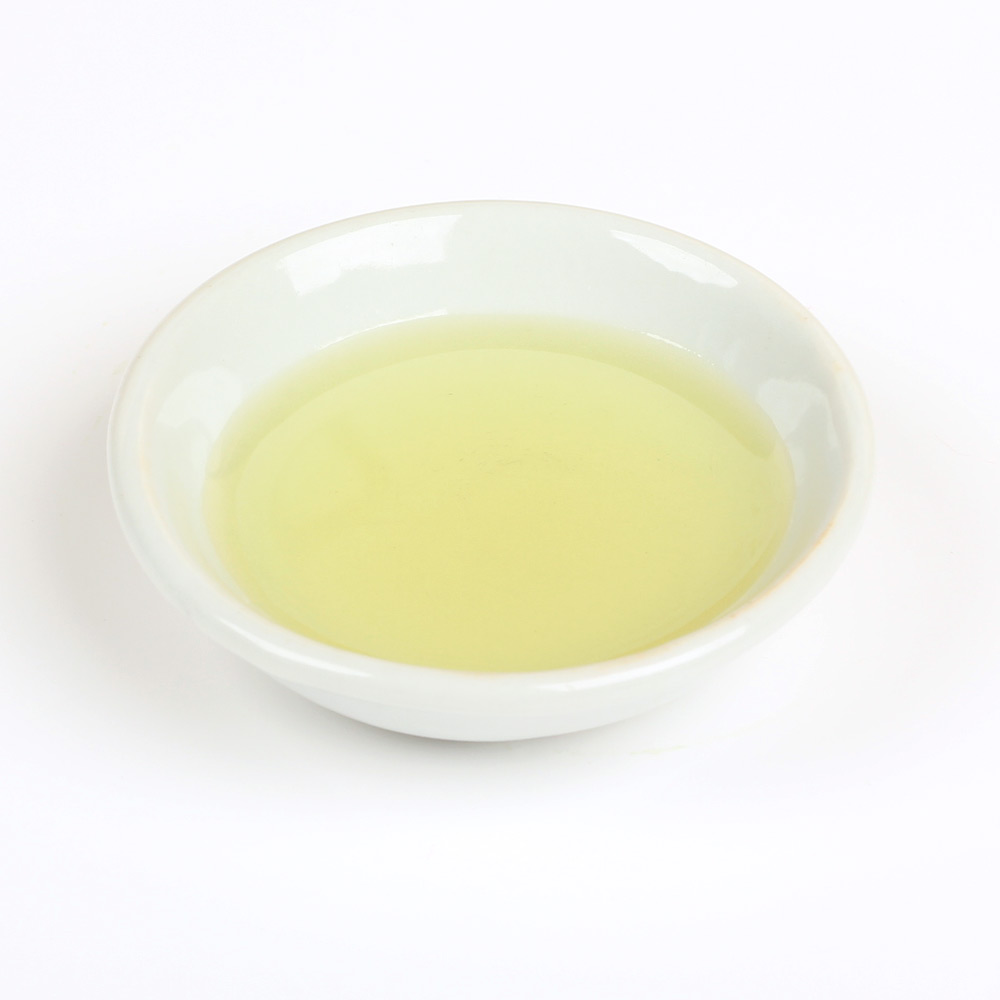
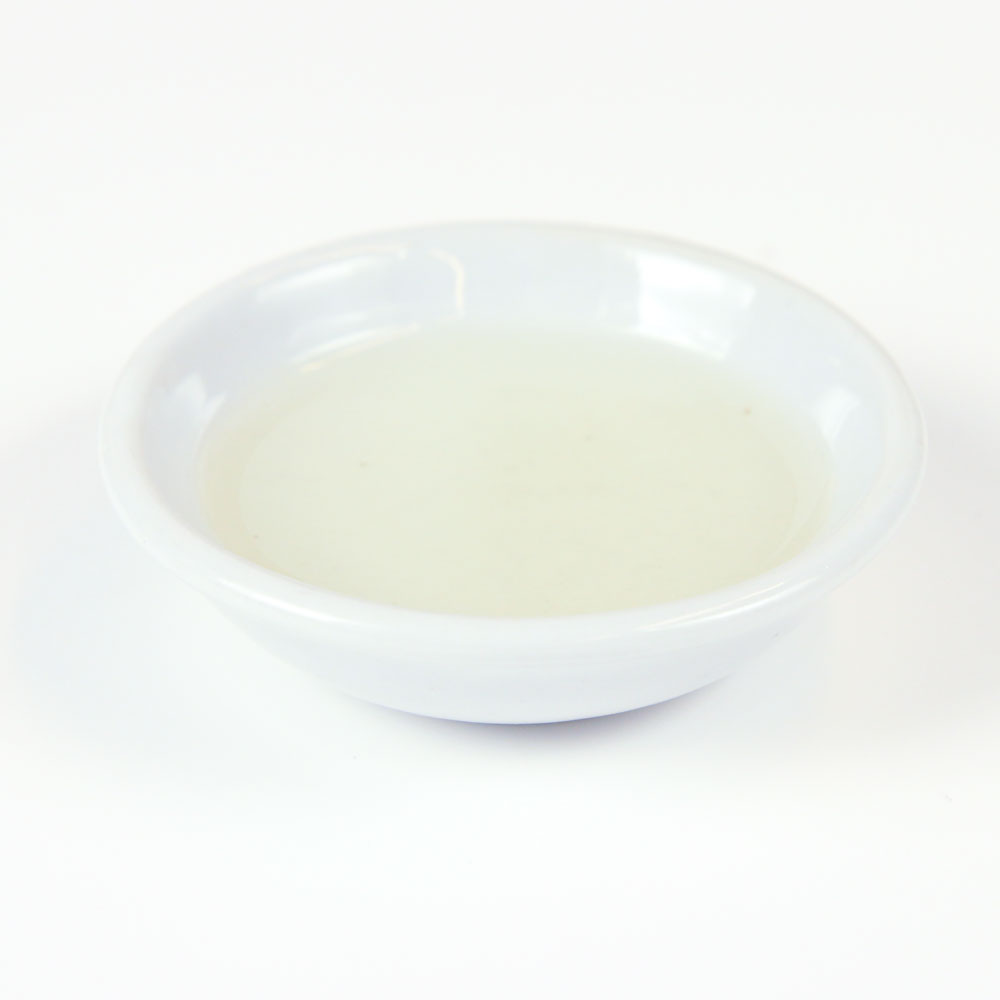

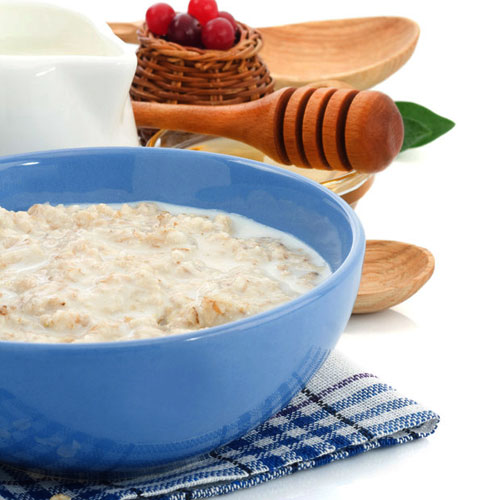


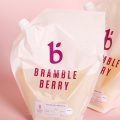
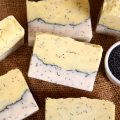

I would like to add some castor oil to this recipe for lather – how much would you recommend, and would this mean reducing the other oils, or just adding it in.
We recommend adding Castor Oil 3-5% of your recipe for a creamy lather. You can reduce your other oils by that percent. You will want to run your recipe through the Lye Calculator with the new oil amounts to get your adjusted lye / water mounts.
Lye Calculator: https://www.brambleberry.com/calculator?calcType=lye
Hi, Newbie here! Wondering if you could offer some advice. I’m hoping to make this recipe but would I be able to substitute the Lots of Lather mix in for the oils? I’ve been trying to find a super soothing goats milk, oatmeal, and honey recipe for my daughter who suffers from eczema. Hoping I can find a way to modify this one a bit so it will work. Thanks for your help!!
You can definitely modify this recipe and use the Lots of Lather Quick Mix. Just make sure to run the amount of quick mix you’re using through the Lye Calculator to make sure your Lye and Liquid (goat milk) amounts don’t change too much.
Lye Calculator: https://www.brambleberry.com/calculator?calcType=lye
Wanted to use this recipe substituted with coconut milk when I’m out of goats milk. Would you suggest freezing the coconut milk like the goats milk? Or using distilled water for half the liquid amount and making a lye solution with that Then mixing the other have of the liquid using coconut milk in after adding the oils.?
I would recommend freezing the Coconut Milk before adding your Lye to it like you would the goats milk.
Some people also will add the milk in at trace though normally that is when you are using the powder and use just add enough distilled water to help blend it into the soap batter. You wouldn’t normally add as much as half of your liquid at that point.
Coconut Milk Powder: https://www.brambleberry.com/Coconut-Milk-Powder-P5669.aspx
Was wondering if the fragrance in the recipe is by weight or liquid volume.
By weight. We recommend measuring almost all recipes, especially cold process soap, by weight for the most consistent results.
I made this soap with powdered goats milk reconstituted to 11.6 Oz and added 2 tsp of sodium lactate. Everything else was per recipe. Oil was 123 and lye was 87 when I mixed it. It looked great but when I pulled it out of the freezer there was a gel circle throughout. I was ok with it but when I cut it, some of the layers crumbled. The pH looks ok on litmus. And it has zero lather.
I’d like to try again but I would rather know if I can prevent the crumbling?. And is the lack of lather normal? Thank you. I’ve just started soaping and have made about a dozen of your recipes. I really appreciate your site and products. This is only my second problem child and ironically the other problem was crumbling too.
Did the crumbling happen immediately after removing from the freezer? If so that would be the reason why. We recommend waiting at least two days before cutting your soap after you had it in the freezer. Lather increases the longer the soap cures. I would wait at least a week into the cure before attempting to check the lather of the bars.
Does the titanium dioxide reduce lather in this recipe? I’ve heard that it does.
Greatly overusing a colorant can negatively impact lather, but we didn’t notice any reduction in lather with this recipe.
I was given some goat milk, already frozen in cubes. I saw somewhere that you should weigh out liquid milk and then freeze exactly what you need in cubes. Would it be necessary, then, for me to thaw and weigh liquid milk and refreeze it? Or could I just weigh out the frozen milk? Seems like thawing and refreezing might break down some of the good qualities of the milk.
You can weigh the milk frozen and try to chip it away to get to the amount you need if they are larger cubes.
I recently made a batch of soap following this recipe. I followed the directions exactly except I used black amber and lavender fragrance oil instead. I left the soap I the mold for 3 days, then took it out. It was beautiful. However, the more time it’s sat out, the darker it’s becoming in color. It’s almost brown at this point? What did I do wrong?
Our Black Amber and Lavender fragrance oil discolors to brown as seen here: https://www.brambleberry.com/black-amber-and-lavender-p3331.aspx
To stop this from happening you would want to use a fragrance oil that does not discolor in cold process soap.
So, I have recently figured out that I am allergic to coconut and most of its derivatives. I don’t think that palm oil is a safe bet either.
I was looking for a soap I can use. This looks good, but do you have any suggestions to replace the coconut oil? And if so, how much percent should it be, as I know some oils are thicker.
Palm Kernel Oil, Lard, and Babassu Oil all make suitable substitutes for coconut. Once you make the swap, use our lye calculator to get your new water/lye amounts: https://www.brambleberry.com/Pages/Lye-Calculator.aspx You should be able to use them at the same rates/ratios as the original recipe called for in coconut oil.
Hi, I love you websites & tutorials and have learned tons about making soap. I’ve made this Creamy Goat Milk Soap about 8 times and really like it’s properties. I’d just like it to be slightly harder overall. I do add the sodium lactate, but beside that, what would you recommend changing?
Also, is the 11.6 oz of goat milk, in fluid ounces or by weight ounces. I’ve seen in one of your tutorials that goat milk should be measured in fluid ounces, but it doesn’t specify which is called for in this recipe. Thanks!
You can do a water discount to help harden the bars as well. I would start with 10% discount and that should help a bit. In the recipe we go by weight and not fluid ounces.
I would like to use kaolin clay instead of titanium dioxide for the white color. How will this affect my soap?
Thank you
Kaolin clay is used more for the properties that it lends to soap, rather than the color. Titanium Dioxide will be your best bet to get a nice creamy white color. Here’s a blog post we did with more information on how to use clays in beauty products: https://www.soapqueen.com/bath-and-body-tutorials/tips-and-tricks/how-to-use-clay-in-bath-beauty-projects/
Great recipe! I’ve been Soaping for about 2 years making liquid soaps. This was my 3rd bar soap recipe I’ve made. It went very well with no issues and no burnt goat milk! Looking forward to making my next goats milk soap soon.
Question: Can lactic acid be used in place of sodium lactate?
We don’t recommend using lactic acid instead of sodium lactate. If you don’t have sodium lactate, you can use a salt solution. To make the solution, mix 1 teaspoon of regular table salt into 1 ounce (by weight) of warm distilled water. Stir until the salt is fully dissolved. We recommend 1 teaspoon of salt in 1 ounce of water per pound of soap.
This post talks about sodium lactate: https://www.soapqueen.com/bath-and-body-tutorials/tips-and-tricks/unmolding-cold-process-soap-from-plastic-molds/
Here is a palm oil question based on your directions: I have used palm oil in a few batches of my beginner soap. I didn’t know anything about melting the whole container first & would like to know what is the reason for that? I don’t know if it made a difference in my soaps. I have certified sustainably grown palm oil which comes in a small container; how would I melt that?
Palm oil is composed of various fatty acids, one of which is stearic acid. The stearic tends to sink and solidify first as the liquid oil cools. This means the stearic acid is unevenly distributed throughout the palm oil container and can do some weird things in soap, like create solid specks in the bars.
If your palm oil is in a container, you can scoop it into a heat-safe container, melt, and mix thoroughly before adding it to your recipe.
Our palm oil comes in heat-resistant bags that you can reheat multiple times: https://www.brambleberry.com/Palm-Oil-P3210.aspx
Excited to try this recipe! Can you recommend a substitute for palm oil?
Babassu oil can be used in place of palm oil: https://www.brambleberry.com/Babassu-Oil–P6807.aspx
You can also add a hard oil like cocoa butter up to 15% to add firmness like palm oil does. Coconut oil or tallow up to 33% work as well. Read more about common oils and what properties they add to soap here: http://www.soapqueen.com/bath-and-body-tutorials/tips-and-tricks/free-beginners-guide-to-soapmaking-common-soapmaking-oils/
This post on substituting oils has some great information too: http://www.soapqueen.com/bath-and-body-tutorials/tips-and-tricks/how-to-substitute-oil-in-cold-process-recipes/
Thank you 🙂
Hello
My goats milk soap is suddenly all getting soda ash, I soap in a shed and I have had no issues before, but suddenly every batch is getting soda ash.
I make the lye and milk solution first, before melting the oils, so the lye is much cooler when it gets added to the oils, I then bring it to a light trace and pour into molds which are then placed in to the freezer for 48hr, after tens min in the freezer I spray with alcohol spray. The bars come out of their molds fine and then suddenly they are covered in soda ash, can you see what I am doing wrong? I have a dehumidifier in the shed.
Please help.
Thank you xx
We’ve noticed we get more soda ash in the winter when it’s colder, so that may be the reason you’re getting more now. It’s also common with milk soap that has to be kept at lower temperatures.
You may try a milk discount of about 10%. We’ve found that helps prevent soda ash even with lower temperatures: http://www.soapqueen.com/bath-and-body-tutorials/tips-and-tricks/water-discounting-cold-process-soap-how-why/
If you are still getting it, you can easily steam or wash it away. This post shows you how: http://www.soapqueen.com/bath-and-body-tutorials/tips-and-tricks/explaining-and-preventing-soda-ash/
Is it the scent that discolors in this recipe or the goat milk?
It’s mostly the scent that discolors this recipe. When you freeze milk and keep it cold during the process, it helps prevent a lot of discoloration.
This post has more on working with milk: http://www.soapqueen.com/bath-and-body-tutorials/tips-and-tricks/how-to-add-lye-to-milk-for-cold-process-soap/
If I were to not reconstitute the goats milk powder and add it in in powder form at trace, how much should I use ppo?
Thanks!
You can start with about 1 teaspoon per pound of soap and add more from there if you like. Make sure to keep the soap in the fridge or freezer afterward to keep it cool.
Goat milk powder: https://www.brambleberry.com/Powdered-Goat-Milk-P4933.aspx
i will prepare a home made goat milk soap .so how to percentage add to goat milk for 100g soap.
You can use our Lye Calculator to find out how much to add: https://www.brambleberry.com/Pages/Lye-Calculator.aspx
Add your oil amounts and then click “Calculate.” The “liquid” portion is how much goat milk you want to add.
Learn how to use the calculator here: https://www.soapqueen.com/bath-and-body-tutorials/tips-and-tricks/using-the-bramble-berry-lye-calculator-2/
Can honey be added to this and if so when and how much? Thanks!
You can add honey to this recipe. But, it’s important to keep in mind that honey will cause the soap to heat up due to the sugar content. This can be undesirable when making milk soap, as the soap can scorch if it becomes too hot.
In general, use about 1 teaspoon of honey per pound of soap. You can certainly use more, but keep in mind the more honey you use, the hotter your soap will get. Some soapers add their honey to the soap directly during trace. Others prefer to dilute the honey in a portion of the water in their recipe, and add this mixture at trace.
You can learn more about using honey in soap in this post: https://www.soapqueen.com/bath-and-body-tutorials/tips-and-tricks/adding-honey-to-cold-process-soap-tips-tricks-recipe/
Can colloidal oatmeal be added to this recipe and if so when and how much. Thanks!
You could add colloidal oatmeal if you’d like. Colloidal oatmeal can be dispersed in a lightweight liquid oil and added at trace. We recommend 1 tablespoon of oil for every teaspoon of colloidal oatmeal. A good place to start is 1 teaspoon per pound of soap, but can be adjusted depending on preference.
I used cold pasturized goat milk from the supermarket and when I added the lye, it formed a layer of what looked like coagulated milk and was a very dark orange liquid underneath. Could it be due to additives in the milk? Or was the temperature too high and “cooked” the milk? I diluted it and poured it down the drain as I didn’t know what was happening.
It sounds like the lye may have reacted with some of the fat in the milk. That can happen. Was the milk frozen when you added the lye?
No the milk wasn’t frozen. I had it frozen in a block (forgot to use the ice cube trays!) then left it on the counter to melt a little so I could measure out the required amount.
I think that will help for next time. When the milk is frozen, there’s less of a chance of the lye reacting. To keep it really cold you can also place the lye container in an ice bath. Once the lye is fully dissolved, you can get started on your soap.
Learn more about working with milk here: http://www.soapqueen.com/bath-and-body-tutorials/tips-and-tricks/how-to-add-lye-to-milk-for-cold-process-soap/
When will the Cocoa Butter cubes be back in stock? I have never seen this item out of stock before and I am out…….
We no longer have the cocoa butter cubes, but we do have cocoa butter wafers. They’re easy to measure and melt: https://www.brambleberry.com/Organic-Cocoa-Butter-Cubes-P6365.aspx?
Can I use Olive Oil if I don’t have Pomace Olive Oil? Also the coconut oil is this ratiocinated or 76/96 degree
Yes, you can use olive oil pure in place of the pomace. They have a similar feeling in the soap, the main difference is pomace accelerates slightly while pure doesn’t.
Olive oil pure: https://www.brambleberry.com/Olive-Oil-Pure-P5246.aspx
The coconut oil is 76 degrees: https://www.brambleberry.com/Coconut-Oil-P3196.aspx
Hello, I’m fairly new to cold process soap making, but very excited to try this recipe. I’d like to use essential oil in place of the fragrance oil as I’m looking to make a soap with a sandalwood scent. It appears I would need quite a bit of oil for this recipe and sandalwood seems to be incredibly expensive. Do you have any suggestions of possibly another EO that resembles sandalwood that is more cost effective?
Thank you so much!
I would recommend cedarwood essential oil: https://www.brambleberry.com/Cedarwood-Essential-Oil-P4897.aspx
It has similar earthy and woody qualities to the sandalwood. It’s also nice and strong, so a little bit goes a long way.
Find out how much to add with the Fragrance Calculator: https://www.brambleberry.com/Pages/Fragrance-Calculator.aspx
Seems like a silly question, but does this recipe still work if I double it? I’d rather buy the 18-bar mold than the 9-bar.
Thanks!
Yes, you can double this recipe if you like. You can run it through the Lye Calculator afterward to be extra careful: https://www.brambleberry.com/Pages/Lye-Calculator.aspx
hi.. that’s a fab recipe. I want to know one thing, is it okay to discount the water completely with milk? because i have seen some people use half water and half milk.. please reply..
regards
sasha
You can use all milk for this recipe, all distilled water, or a mixture of both. All those methods work well. If you’re using any milk, you’ll want to keep it cool using the method shown above.
Anyone else having printing issues? After I click print recipe the page comes up gray
I printed a test page and it looks OK on my end. You may want to contact your printer manufacturer to see if they can help.
It isn’t the printer but I was curious if it shows up black/gray when other hit the print button. Everything else prints.
The background is gray, but you should still be able to see the text in the print preview. Are you seeing that?
What is the lye concentration and SF so I call run out through a soap calc.
I believe our lye concentration is around 33% and the superfat is 5%. We formulated this recipe with our Lye Calculator: https://www.brambleberry.com/Pages/Lye-Calculator.aspx
Learn more about how to use it here: https://www.soapqueen.com/bath-and-body-tutorials/tips-and-tricks/using-the-bramble-berry-lye-calculator-2/
I was trying to read through the comments but couldn’t find answer to my question. I apologize if it’s repetitive. If I don’t have apricot kernel oil in hand, what will be a good substitute?
Sweet almond and hazelnut oil have a similar consistency, so they work well as substitutes.
Sweet almond oil: https://www.brambleberry.com/Sweet-Almond-Oil-P3205.aspx
Hazelnut oil: https://www.brambleberry.com/Hazelnut-Fixed-Oil-P3197.aspx
Remember to run your recipe through the Lye Calculator after any substitutions: https://www.brambleberry.com/Pages/Lye-Calculator.aspx
And this post has more information on substituting oils: http://www.soapqueen.com/bath-and-body-tutorials/tips-and-tricks/how-to-substitute-oil-in-cold-process-recipes/
If I can’t spring for the large divided birch mold what other molds or trays will work?
I’m not entirely sure, you may use the dimensions of the liner to find a box or tray that will work: https://www.brambleberry.com/Silicone-Liner-for-9-Bar-Mold-P5812.aspx
You can also buy a silicone mold like this 10″ Loaf Mold: https://www.brambleberry.com/10-Silicone-Loaf-Mold–P5199.aspx
It’s sturdy so you don’t need to place it in a mold, it works on its own. Then you can use this post to resize the recipe to fit it: https://www.soapqueen.com/bath-and-body-tutorials/tips-and-tricks/how-to-resize-cold-process-soap-recipes/
I would like to add some oatmeal to this recipe. What do I need to know to be successful?
Do you want to add oats, or colloidal oatmeal? Let me know and I can give you some tips.
Colloidal oatmeal: https://www.brambleberry.com/Colloidal-Oatmeal-P5565.aspx
-Kelsey with Bramble Berry
Hello there!
I had written up a comment but don’t see it posted….so I’m Asking again, please bear with me. Firstly thank you so much for all your help and patience with our questions. Your comments/answers actually are lessons by themselves in this terrific journey of soaping!
So yesterday i made gorgeous camel milk soap cold process (i made a mistake and typed goat’s milk in my last question) and it remained a lovely off white colour. However, i think it may have been a false trace and my lye and oils haven’t saponified! The oils and butters were liquid at around 77 degrees F and the lye mix was around 56 degrees F (or it could be the other way around lol i cant remember a bit here). Were the oils too cold? I have no idea how to tell if they are soap or not. they are in the fridge and hardened up and feel like lotion bars when i touch them. How can i tell if they have saponified? I would hate to ruin the gorgeous colour i was able to achieve by hot processing it. God bless you for your help and your constant supervision of us kiddies here.
Do you notice any pockets of liquid in the soap, or do you see liquid pooling on top? Does the soap have an even appearance, or do you notice any spots in it?
-Kelsey with Bramble Berry
I have been using hot process (semi frozen milk and then getting the oil mixture and milk/lye mixture to 95 degrees before mixing). Could I use this same recipe with hot process? If I did what else would be different?
Thanks,
Andi
Hot processing milk soap can be tricky. Because it needs to be heated for a long period of time, the milk will scorch. That causes discoloration and an unpleasant smell (that goes away with curing). You can add the milk at the end, but because the soap is mostly done saponifying the milk may not fully turn into soap.
If you’re OK with that discoloration, you can hot process the soap. The discoloration doesn’t affect the quality, it just affects the way it looks. Learn more about working with milk here: http://www.soapqueen.com/bath-and-body-tutorials/tips-and-tricks/how-to-add-lye-to-milk-for-cold-process-soap/
-Kelsey with Bramble Berry
Can u tell me what the superfat and water discount are in this soap? And can I use something else instead of apricot kernal oil? Thank u
This soap is superfatted at 5% and it doesn’t have a water discount. You can adjust the superfat or add a water discount if you like. A water discount will help the soap unmold and cure more quickly.
Learn more about superfatting here: http://www.soapqueen.com/bath-and-body-tutorials/cold-process-soap/superfatting-soap-an-explanation-2/
And more about water discounting here: http://www.soapqueen.com/bath-and-body-tutorials/tips-and-tricks/water-discounting-cold-process-soap-how-why/
In place of apricot kernel oil, you can use sweet almond or hazelnut. Just make sure to run your recipe through the Lye Calculator after any substitutions.
Lye Calculator: https://www.brambleberry.com/Pages/Lye-Calculator.aspx
This post has more on substituting oils in cold process recipes: http://www.soapqueen.com/bath-and-body-tutorials/tips-and-tricks/how-to-substitute-oil-in-cold-process-recipes/
-Kelsey with Bramble Berry
I have a coconut allergy. What can I use as a substitute? Thank you in advance!
There is no substitute for coconut oil, but you can replace it with olive oil. That will make the bars a bit softer, so you may want to increase the palm oil to 33% and the cocoa butter to 15%. That will firm it up a bit. Make sure to run the recipe through the Lye Calculator after any substitutions: https://www.brambleberry.com/Pages/Lye-Calculator.aspx
This post on substituting oils has more information as well: http://www.soapqueen.com/bath-and-body-tutorials/tips-and-tricks/how-to-substitute-oil-in-cold-process-recipes/
-Kelsey with Bramble Berry
You can actually replace Coconut oil for Babassu Oil. It’s more expensive but I use it in a lot of my specialty bars as it a little more gentle on the skin. Also, people with coconut allergies usually can use Babassu Oil. I love using Babassu Oil and if I could afford it would completely replace it for coconut oil in my soap. Goodluck ☺️
Can i use this soap on my beard? What i mean by that is, is it moisturising while not stripping away too much of natural oils?
This soap is very moisturizing – goat milk has a nice creamy feeling. You can definitely give it a try on your beard. If you find it’s not working well, you may like this Sudsy Shampoo Bars recipe: https://www.soapqueen.com/bath-and-body-tutorials/cold-process-soap/sudsy-shampoo-bars/
-Kelsey with Bramble Berry
Thank you for the fast reply.
Btw, i have made a goat milk soap, but a little bit different recipe.
Castor Oil: 6.5% 45g
Olive oil: 59.4% 411g
Coconut Oil 21.7% 150g
Shea butter 6.5% 45g
Cocoa butter 5.9% 41g
Lye 94.5g
Goat milk 228g
Made it yesterday, and now 24h later, its firm, looks creamy, feels creemy, but, when i was my hands with a sample, it dries out my skin.. Is it because it’s just 24h after the pouring, or is it something else?
I’m not sure why that’s happening, the ingredients should help moisturize the skin. You may give it a couple days and try again. During the first two days the lye is still chemically reacting with the oils, so there may be some active lye. You can try the bars again after 5 days or so. Also, you’ll want to handle the bars with gloves for those first few days just to be extra careful.
-Kelsey with Bramble Berry
I recently bought a shrink wrap machine for my soaps and the person that sold it mentioned that goat milk soap soap should be wrapped in the non perforated wrap. I’m wrapping my soap because I like the look but am wondering if goat milk soap should be wrapped to prevent spoilage or rancidity?
You can wrap goat milk cold process soap. We recommend letting the bars cure for a full 4-6 weeks so that any excess liquid can evaporate. It also helps to have an opening in the wrapping (like shrink wrap does) just in case there is any leftover liquid. If the soap is wrapped too early that liquid can get trapped and the bars can go rancid more quickly. Learn more here: http://www.soapqueen.com/bath-and-body-tutorials/tips-and-tricks/how-to-store-handmade-bath-products/
-Kelsey with Bramble Berry
I cannot wait to get more soap making experience under my belt so I can try this one out! Two modifications I keep thinking about: replacing the oatmeal milk with lavender (infusion? essential oil? additional coloring? combination of above?) and replacing with a “masculine” essential oil (cedar blend? DIY Old Spice blend?) I’m toying with the idea of using this as wedding favors, but first more research!
You can swap out the scent if you like. Essential oils are a great option because they fragrance the batch more than oil infusions. Learn how much to add with our Fragrance Calculator: https://www.brambleberry.com/Pages/Fragrance-Calculator.aspx
Lavender 40/42 essential oil: https://www.brambleberry.com/Lavender-4042-Essential-Oil-P3664.aspx
As for an Old Spice blend, a mix of cedarwood, cinnamon, and clove would get you something similar. Find those essential oils here: https://www.brambleberry.com/Essential-Oils-C157.aspx
And learn how to blend essential oils here: https://www.soapqueen.com/bath-and-body-tutorials/tips-and-tricks/how-to-blend-essential-oils-safely/
-Kelsey with Bramble Berry
Still working on a masculine fragrance blend, but I’m also toying with the idea of modifying the colors and fragrance to the Bramble Beer Soap recipe for the men’s favors. Which leads to the next issue, I have several people that are severely allergic to nuts. I’d have to check, but I’m pretty sure that coconut, cocoa, and palm are on the allergy list. Any suggestions on how to deal with this?
I swear I refreshed the page, but it didn’t show your follow-up Kelsey. Thanks a bunch, I can’t wait to try that blend you suggested!
Any oils that come from nuts can cause potential skin irritation. This blog talks more about how to work with allergies and sensitivities: https://www.soapqueen.com/bath-and-body-tutorials/tips-and-tricks/soaping-with-allergies-nuts-gluten-more/
-Kelsey with Bramble Berry
I swear this is my last comment for a while before I start the practical trial phase, but this blog has been such a help in my research phase!
Ann-Marie, Kelsey, and co. are giving Bramble Berry a great image =)
I checked in with Cousin Allergies (she has a bunch), and she said the following recipe base was safe for her. What do you think of the recipe?
Palm Oil 15%
Rice Bran Oil 15%
Avocado Oil 10%
Palm Kernel Flakes 10%
Beeswax 8%
Apricot Kernel Oil 5%
Avocado Butter 5%
Castor Oil 5%
Cocoa Butter (Deodorized) 5%
Mango Butter 5%
Meadowfoam Oil 5%
Peach Kernel Oil 5%
Shea Butter (Refined) 5%
Jojoba Oil 2%
I am concerned about it being soft, so I am considering adding sodium lactate to it (at 1 tsp per lb). I’d like to do a trial run with just distilled water, lye, and vitamin E (at 1 tsp per 1b) to see how it behaves before I add the fun stuff: sugar, fragrances, colorants, and changing the water source (goats milk and beer).
Also, regarding the article on superfatting soap. (BTW, half the articles here won’t let me comment, my engagement level with this site must be at play!) If I want the superfat to be a specific oil (for example, the apricot kernel oil), is it possible, and if so, how would I go about doing this for a CP soap? Perhaps by using it as the carrier oil for the fragrance and colorant and incorporating at trace?
Again, thanks for all the help. I see how hard y’all are working!
That recipe looks great. The palm kernel oil, palm oil, and beeswax will help firm it up. Sodium lactate will help as well. Beeswax has a high melting point, so you will need to have your oils and lye around 180F to keep it melted the whole time. Learn more in this tutorial: https://www.soapqueen.com/bath-and-body-tutorials/cold-process-soap/beeswax-spoon-plop/
For the superfat, you can take the amount of lye that you are supposed to use and multiply it with the following equation (1 – % superfat you want). So, if you wanted to superfat an olive oil soap by 4%, you would do the following (1.34 oz. lye) x (1 – .04) = 1.286 oz. lye. Or you can do the rough ‘n’ easy way; for a one pound batch of soap, a 5% superfat works out roughly to .8 oz. of extra oils per pound of soap.
Learn more in this post: http://www.soapqueen.com/bath-and-body-tutorials/cold-process-soap/superfatting-soap-an-explanation-2/
-Kelsey with Bramble Berry
I’d like to know shelf life of soap with milk.
Soap made with milk will have the same shelf life as soap made with water. When the soap is added, it goes through the saponification and turns into soap, so it no longer has the same shelf life as milk. The shelf life of regular soap is determined by the oils added: https://www.soapqueen.com/bath-and-body-tutorials/tips-and-tricks/shelf-life-bath-products-ingredients-rancidity-vs-mold/
Learn more about working with milk here: http://www.soapqueen.com/bath-and-body-tutorials/tips-and-tricks/how-to-add-lye-to-milk-for-cold-process-soap/
-Kelsey with Bramble Berry
Newbie soaper here. I just unmolded this recipe from a silicone loaf mold and found it had gone thru partial gel. I used a cold mold out of the freezer and froze it for 24 hours after pouring. Should it be left in the freezer longer? I did pour some in bar molds and they look great. Would using the 9 bar mold vs the loaf mold help with the partial gel? Otherwise the soap looks wonderful, creamy and light.
Freezing it for 24 hours is plenty of time. What temperatures were your lye and oils, and were you using a wood mold? Wood molds insulate more than silicone so the soap does get warmer.
-Kelsey with Bramble Berry
Thank you so much for your kind reply. Your blog has been so helpful as I I have become addicted to soaping. If I remember correctly my oils were at 134 and my lye/milk was at 88 (I had it on ice). Maybe I should have let the oils cool more?
Those temperatures should work just fine, your next batch you can have your oils around 120F and the lye around 80F just to be careful. Was your soap in a wood mold?
-Kelsey with Bramble Berry
Thanks for your reply. I used a silicone loaf mold, no wood. I am waiting on another batch of milk but I will try those cooler temps and see if I can avoid that partial gel next time around.
Sounds good, let us know if that helps.
-Kelsey with Bramble Berry
Hi. I love this recipe. Followed it and my bars came out wonderful. I am wondering though if it wouldn’t be easier to just mix the lye with water, and then add the goats milk powder at trace? Wouldn’t that be easier? What are the pros and cons of doing it this way? I have only been making cp soap for several months now. I have seen several people do goats milk this way and it seems like they are not having to worry about temp,etc. what do you think?
Another question please… every time I soap at lower temperatures,even dropping down to 120-110 my soap is always crumbly. With or without soap ash. It just never seems to work for me. I live in Vegas and it is extremely dry here. Maybe I’m impatient and unmolding all my soaps too soon? I don’t know…I’m getting discouraged.
You can add the goat milk powder at trace if you like. It has a tendency to clump up, so you’ll want to stick blend it in. You can also mix the goat milk with a bit of water and add that at trace, just make sure to discount that from your main liquid amount so the soap isn’t too wet. Also, make sure to pop it in the freezer for 5-24 hours still, otherwise it can overheat.
As for the soap texture, how are you storing it? Are you adding sodium lactate? Crumbly soap is usually caused by heat, a lot of butter in the recipe, or a lot of sodium lactate.
-Kelsey with Bramble Berry
I am adding sodium lactate and I think I will try decreasing that by half the recommended amount just to see. After cutting the bars I store them inside my home which is not very hot. Funny thing is, the soaps that I have made with butters in them don’t crumble like the other ones!! Ugh!!! Will try decreasing the sodium lactate first and see what happens. Thank you for trying to help Kelsey.
Absolutely, happy to help. Is there any salt in the recipe? Also, have you pH tested it? Sometimes the crumbliness can be caused by lye heaviness. A pH test will let you know for sure: https://www.soapqueen.com/bath-and-body-tutorials/tips-and-tricks/troubleshooting-lye-heavy-soap/
-Kelsey with Bramble Berry
I’m so bummed-just realized after I made this that I only used 8 oz water and the 1 oz of goat’s milk powder. I forgot to weigh before mixing with the lye. Do I have to throw this whole batch away?
Did you add the 4.9 oz. of lye to the 8 oz. of milk? Let me know and I’ll help you troubleshoot.
-Kelsey with Bramble Berry
yes, I froze the 8 oz of milk into cubes. I slowly added the lye to the cubes and kept stirring till all dissolved. Temp did not go above 92 degrees (had it on top of ice)
As long as that is dissolved, your bars will be just fine. You can pH test the soap just to be extra careful and make sure it’s around 9-10. In essence you did a water (liquid) discount, which many soapers like to do to help the bars harden, unmold, and cure more quickly. 🙂
Learn more about how to test the pH here: https://www.soapqueen.com/bath-and-body-tutorials/tips-and-tricks/troubleshooting-lye-heavy-soap/
And the benefits of water discounting here: https://www.soapqueen.com/bath-and-body-tutorials/tips-and-tricks/water-discounting-cold-process-soap-how-why/
-Kelsey with Bramble Berry
I usually make soaps in the loaf mold however I recently purchased the 9 bar slab mold and liner and I am currently awaiting for them to arrive any day now. With this recipe it looks like its a little over 2lbs of oils (35.1oz). Approximately how many ounces do the finished bars weigh? Thanks.
This recipe weighs 51.6 oz., so each bar weighs about 5.7 oz. when they’re unmolded. They will lose a bit of weight as they cure because any excess liquid evaporates. 🙂
-Kelsey with Bramble Berry
I’m fairly new to soap making, and this may be a silly question, but would it be possible to make this without the fragrance oil? Would I need to reformulate the recipe?
You can definitely leave out the fragrance if you like! It’s an optional ingredient and you don’t need to reformulate the recipe at all. The soap does have titanium dioxide added to combat some of the vanilla discoloration of the fragrance. If you like, you can leave the titanium dioxide out for a creamy off-white color, or add it for a bright white shade. 🙂
Read more about vanilla discoloration here: http://www.soapqueen.com/bath-and-body-tutorials/tips-and-tricks/why-did-my-soap-turn-brown/
-Kelsey with Bramble Berry
I make a goatmilk soap with 25 % Palm and Almond oil, 20% coconut and olive oil and with a little castor oil and shea butter for lather and moisture, superfatted at 5% with a 10% water discount…It lathers extremely well and feels soft and smooth on the skin during the shower, but it seems like my skin feels dry/tight afterwards, as it does with most soap. Is this a function of my skin type or is there a particular oil causing this dryness? Most of my soaps have around 20% of both palm and coconut oil with the same 5% superfat and 10% water discount and I’m wondering if either of those are the culprit?
Coconut oil is nice and cleansing. If your skin is on the dry side, it may be a bit too cleansing. You can drop that down to 15% and add more olive oil. That will make it a bit more moisturizing! If that’s still a bit too drying, you can drop it down to around 10%. 🙂
Remember to run your recipe through the Lye Calculator after any substitutions: https://www.brambleberry.com/Pages/Lye-Calculator.aspx
Learn more about formulating cold process recipes here: http://www.soapqueen.com/bath-and-body-tutorials/tips-and-tricks/formulating-cold-process-recipes/
-Kelsey with Bramble Berry
Thanks so much 🙂
Can I make this in a hot process soap?
Hot processing this soap can be tricky. If you add it at the beginning of the cook, it will likely scorch because it’s being heated for a long period of time. That can cause discoloration and an unpleasant smell. Some soapers do like to add milk at the end of the cook. I’m not entirely sure if the milk will saponify then, as it is added when the soap is finished cooking. You may try a small test batch with milk added at the end to see what you think. 🙂
-Kelsey with Bramble Berry
Thanks I am going to try it with the powder after the cook.
I make hot process goats milk soap all the time. I use 50% of my liquids as milk and the other distilled water. To make the lye liquid solution, I use cold distilled water and add my sodium lactate and a little sugar. After that is mixed, I slowly add my lye and stir until fully dissolved. I have a fan blowing on the bowl and stir off and on until the water temperature drops to 100 to 105*. I wide in the milk fully and then add to my oils. I stick blend until medium trace and put the lid on my crock pot. I keep the temperature in the 140’s to 150 range by switching the crock pot to warm. Leave the lid on the crock pot until it fully gels and then stir real well. Lid back on for 15 minutes and add your FO / EO and whatever you’re doing with color and put into the mold. After soap I’d in the mold, in the frig overnight and cut in the morning. This gas worked very well for me. Hope this helps you.
great article! I have yet to make all milk soap. Question, do you get the same qualities using whole cows milk as the goats milk?
Hi Jan,
I am a dairy farmer, and make cows’ milk soap almost exclusively, but am still in the testing phase before pursuing a more serious business approach. I do sell some bars from time to time, but give away more than I sell for others to test. I have made a few batches with goats’ milk. I used to have a couple of goats, but wasn’t actively making soap at the time. They were just other dairy animals to have around. I do know of a couple of people who have goats, so I do have access to the milk. From my experience, the soap behaves very similar while it is being made. Frozen goat milk will soften up a lot quicker than frozen cow milk, and the cream doesn’t readily separate if you freeze it for future use.
I have been trying to find additional information on the key differences between the two milks, and based on what I found, they are SIMILAR, but goat milk does have some extra properties that are beneficial to skin. Maybe someone else will know the exact differences. I’d like to know myself.
Give both of them a try some time, and use the same recipe for comparison. I can’t comment on store bought milk, only because I’ve never used it. Hope this helps 🙂
Jennifer has a great suggestion! Both cow and goat milk add moisturizing properties to the soap. However, they may perform and feel slightly different. You can make a small test batch with both to see what you think. 🙂
Learn more about working with milk here: http://www.soapqueen.com/bath-and-body-tutorials/tips-and-tricks/how-to-add-lye-to-milk-for-cold-process-soap/
-Kelsey with Bramble Berry
Kelsey,
I’m still collecting soap samples to send to you (and whoever else that wants to try them) so that you can tell me what you think of the cows’ milk being in a bar of soap. Some of them haven’t cured enough, that’s why there has been a delay.
Another thing I did notice, the goat milk bars had a different ‘look’ to them as well. I don’t know how to explain it. I don’t have any more around that I can send, but I would think comparing mine to your goat milk bars won’t be too big of a difference. It’s almost as though you can ‘see’ the textural differences in them, if that makes sense to you.
If there is anybody familiar with making goat cheese, that should give enough of a hint. The curd is much softer, and more delicate, and needs to be handled with care. Artisan cheesemakers buy milk from me, and they will use identical cultures in the cow, and goat milk (they have their own goats). The finished product isn’t even close. I’ve sampled quite a bit of their cheeses, and have also spent a little bit of time working in their creamery. No matter what, there is still a reaction between the milk, and the rest of the ingredients. Each one has its own uniqueness.
I have done identical recipes using both milks, but that was a while ago, and since I do small enough batches, they are usually gone before I can compare the two of them.
That’s very interesting! It’s amazing how one ingredient can have a big impact on the bar. That makes it fun to keep experimenting. 🙂
-Kelsey with Bramble Berry
How do I make this using goats milk powder?
It’s really easy to use! Mix 1 ounce of the goat milk powder with 8 ounces of distilled water and stir to fully incorporate. Then, you can prepare like normal – freeze the milk, add the lye slowly, and add to your batch. For this recipe you can prepare 16 ounces and save some for later in the freezer. 🙂
Powdered goat milk: https://www.brambleberry.com/Powdered-Goat-Milk-P4933.aspx
-Kelsey with Bramble Berry
What is the difference between olive oil and olive oil pomace? Are the two interchangeable?
Pure olive oil is from the first pressing of the olives, and in soaping recipes it allows you lots of time to work with your design. Pomace, on the other hand, is made by extracting the last bits of oil and fat from the paste leftover from pressing the extra virgin olive oil. It tends to trace much more quickly than pure olive oil, so it’s best for simple recipes. Both add really nice moisturizing properties to your soap. 🙂
Read more here: https://www.soapqueen.com/bramble-berry-news/olive-oil/
-Kelsey with Bramble Berry
I don’t make a lot of soaps with liquids other than distilled water. But when I do I will use about 1/4 of the liquid, or just distilled water depending on what the liquid is, to mix in my lye. When it cools I can add in the rest of my liquid. Much easier than freezing and endlessly stirring down all the lye.
Thanks for sharing that tip Michael! That’s a great way to speed up the process if you’re using mostly distilled water. 🙂
-Kelsey with Bramble Berry
I only make soap with goat milk, and my trick (for whatever it’s worth) for making sure all the lye is dissolved is to take the temperature of the lye + milk mixture after all the frozen milk has melted and I think all the lye has dissolved. I stir for awhile and take the temperature, which (for me) is usually between 70 and 85 degrees depending on how big my chunks of frozen milk started out. Then I keep stirring for a few minutes and stop to take the temperature a few more times. If I see the temps continuing to hold steady or go up as I stir, I assume more lye is dissolving and heating up the mixture, so I need to keep stirring! If I see the temps trending down/cooler? At that point, I assume the lye has all dissolved (no longer more lye heating up the milk) and my stirring is cooling the solution. Hope this helps someone!
That’s an awesome tip Meg, thank you so much for sharing! 🙂
-Kelsey with Bramble Berry
Can we use a different color, or will this mess with the goats milk color.
You can use another color if you like! Make sure to freeze the milk beforehand and keep temperatures low. That will prevent the milk from discoloring too much and affecting the other colors you add. Keep in mind even when kept cool, the milk can cause a yellow tint in the soap. So, if you add green, it may look more yellow when mixed with the yellow batter. Learn more here: https://www.soapqueen.com/bath-and-body-tutorials/tips-and-tricks/how-to-get-vibrant-colors-in-soap/
-Kelsey with Bramble Berry
I seriously want to eat that bar of soap. Looks so yummy!
Thanks for the recipe. Can’t wait to try it out.
btw, I have a question with colorants.
Are there any limits on how much you can add?
I’ve mistaken to rebatch the colorants when rebatching my soap to 1/4 the portion
and the result came out really really dark and messy(not what I wanted).
So will it be just my dissatisfaction on the way it looks, or will there be any sort of concerns such as skin irritation that I should be aware of?
You’re welcome, glad you like the recipe! Soap that has too much color will be just fine to use on the skin. It may lather color and transfer, so if that’s the case make sure to rinse thoroughly and have a rag nearby to wipe away any transfer. 🙂
-Kelsey with Bramble Berry